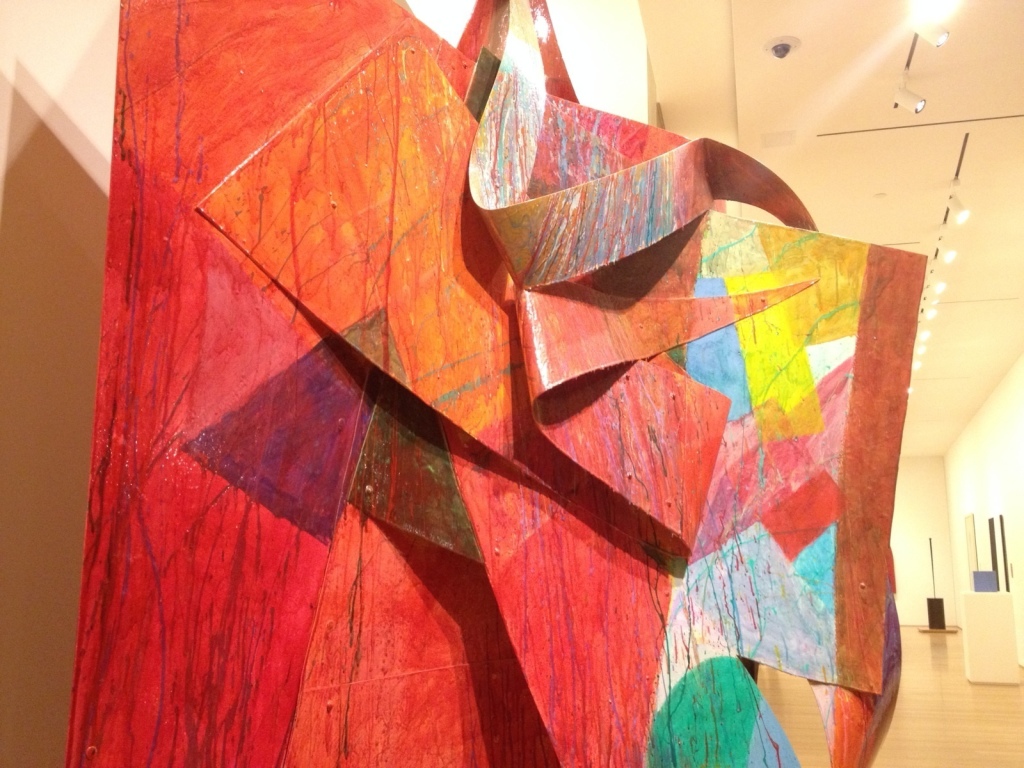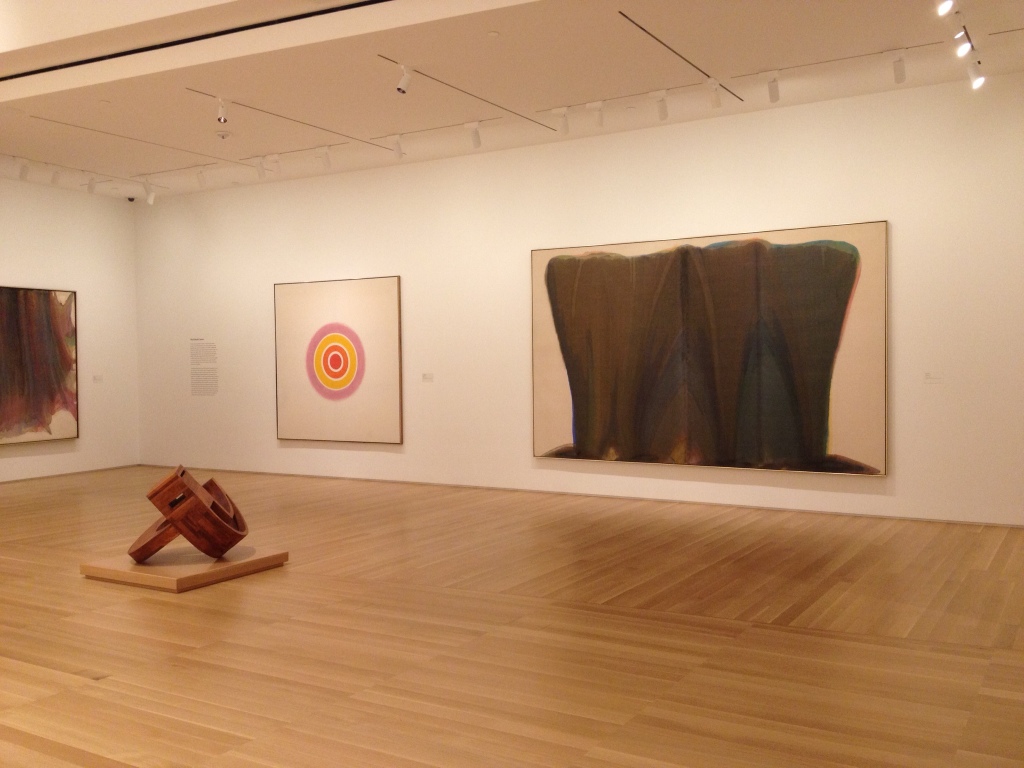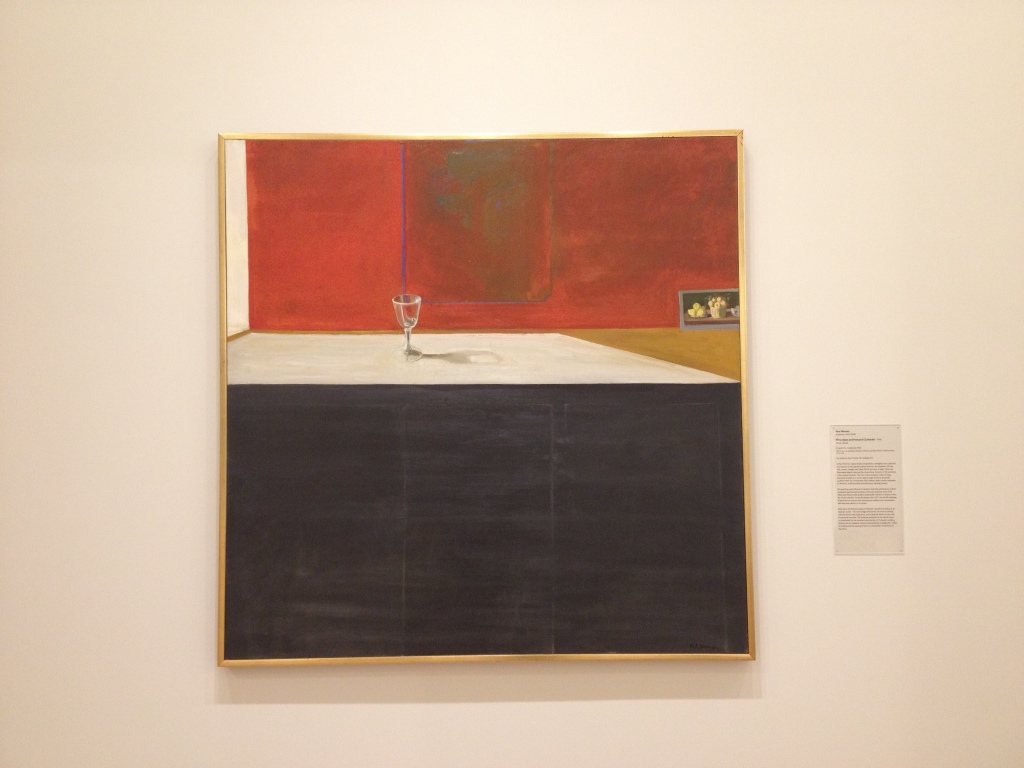At the Stanford Arts Review, we find the Andersons’ generous gift to Stanford a cause for both public and intimate celebration. We encourage you to visit the collection, force your expectations of art out the door and open yourself to discomfort. For what is modern and contemporary art, after all? Scribbles on a canvas, clean lines, exultations of color that arise in all their material glory from the human mind.
We now bring you a weekly series where our writers confront each painting and sculpture in the Anderson Collection, from 001 to 121. This week: John Holland’s Votto, Morris Louis’ Pendulum, and Paul Wonner’s Wine Glass and Postcard.
019. Connor Kelley on John Holland’s Votto

Tom Holland’s Votto defies most methods of description. At once it feels like a hunk of psychedelic taffy flattened, stretched, bent, and frozen into some sort of labyrinthine figure. Or maybe it’s a tragic car crash of two clown cars that have somehow been reordered and stood upright. Better yet, something about it also suggests a Jackson Pollock or (a more colorful) Franz Kline extruded from its two-dimensional plane.
Each of those similes do a half-decent job of describing what exactly Votto is. You get the metal from the clown car, the colors from psychedelic taffy, and the forms from Pollock, but the combination thereof brings another level to the sculpture. It is all of those things and none at the same time.
For one, Votto is made out of aluminum, which automatically puts it in a different sphere than many of its neighbors at the Anderson. Long gone is gesso, wood, oil paint, and canvas. Holland elects to work with aluminum for its newness, but also for its ability to break the picture plane. The sculpture at hands bends and curves with never-ending curiosity, asking the viewer to explore its many nooks and crannies. If nothing else, Votto is an experiment with the idea of the 3D painting – something that collapses the rectilinear world of the painting and Abstract Expressionism.
As an object, Votto is an exciting piece with which to commune. Because of its size and materiality, expressive color and absent message, Votto can kind of become whatever you want it to be. Whether it be a piece of taffy, a clown car crash, or a 3D Pollock, each is accommodated by Holland’s sculpture. Ascribe emotions at will and enjoy.
020. Katie Zingheim on Morris Louis’ Pendulum
 “It looks like it’s falling,” my friend says to me. Now I see it, too, although my first thought was that it was being picked up, gathered from the unseeable space above the canvas, a woman holding up the trailing layers of her dress.
“It looks like it’s falling,” my friend says to me. Now I see it, too, although my first thought was that it was being picked up, gathered from the unseeable space above the canvas, a woman holding up the trailing layers of her dress.
Pendulum, by Morris Louis, the title reads.
The piece is tucked into a back corner of the Anderson collection, hard to notice until you turn and are suddenly facing it. It’s made of overlapping colors, billowing out at the bottom like food coloring being dropped in water. Or maybe coffee stains, the edges of each swath of color a bit darker than the center. The effect is what I always tried to achieve when I was a kid and painting with watercolors, but my attempts always turned muddy brown.
Pendulum. Back and forth, swinging from one extreme to the other. Day swinging to night, swinging back to day again with inevitable momentum. Happiness swinging to sadness, swinging to happiness. Feeling loved; then the heavy downward rush, stomach dropping out, and I swing into loneliness. Loneliness swings back into love, giddy and disoriented, and love swings back into loneliness.
None of these emotions ever stay for too long. I can’t seem to grab onto anything stable at the top of the pendulum swing, anything I take hold of dissolves away and I’m soon swinging back to the other side.
What did the clear, bright blue of love look like? I can’t remember, it’s mixed in with all the others. What about sadness’s unsatisfying gray mist? Not even that can be parceled out, it’s spilled over with pinks and turquoise. Looking back at the years, standing ten feet away, gazing up at them hanging on the tall, white wall, I see how each experience fed into all the others, how all the colors leave an overall impression. No feeling remains singular, but no feeling ever really fades.
“Excuse me, miss,” I hear somewhere close to me, jumping with surprise. I turn to see a security guard, an impulsive “Like me!” smile already spread out on my face. “You’ll have to go back downstairs and check your bag into the coat check.”
I give the painting one last glance before I turn away, and the colors seem to have become brighter as I was looking at it.
021. Jenna Shapiro on Paul Wonner’s Wine Glass and Postcard

It occurs to me that I just drank a full glass of red wine without knowing it. The solitary wine glass meets my eye level as its sole viewer; I almost reach for the postcard curiously overturned to conceal its message, its backside image of Baroque fruit and a rose just nearly inserting life into my otherwise deserted room. You, too, would claim a glass of wine in a room if no one else was looking.
I feel as if it is not my first glass, but my fifth, and I have just rocked out to Pearl Jam on a white sofa-couch in pleather leggings and camo high socks. The words of my epistoler sit on the other side of my card and carry good news. These words are the “pouring kind”: the kind that, like red wine at a good dinner party, spill over the edge and bridge whatever miles in between. Words like these blanket white sofa-couches and carpets so as to permanently stain the earth itself — so that no matter where you are, you and your friend or valentine or sister can be tipsy together in life’s goodness.
My personal dance party stops. I realize the postcard might have contained the opposite, unsavory “sipping kind” of words. Bitter news of continued disconnect that I had to sip through pursed lips in anticipation of the sharp, cheap Charles Shaw taste down my throat.
It’s Week 8, and I have consumed multiple glasses of both: the pouring, jump-for-joy news that my brother will visit soon, as well as the less tasteful understanding that I have two essays due tomorrow and I shall begin them at 11pm. But today, I have decided to dance. Paul Wonner shows that a glass completely empty can still be a glass half-full. Dance.
